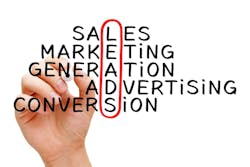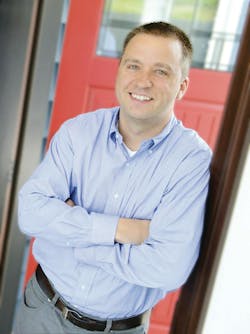Home Improvement Powerhouses Weigh In on Lead Gen
Owner
West Shore Home
Repeating connections with customers
Headquartered in Penn., West Shore is active in eight states selling and installing multiple product lines. On a typical day, the company receives between 800 and 1,000 new inquiries. It culls these to schedule 500 to 600 appointments, of which about 120 turn in new projects. West Shore’s annual sales are $350 million.
The company is focused on establishing “multiple touch points with the same audience,” Werzyn explains. To that end, West Shore has gotten away from face-to-face marketing like trade shows, in favor of traditional media and digital marketing.
Television drives the marketing, although Werzyn is also keen on Facebook, which he says is the most agile medium for building specific audiences. And Facebook is now being used by an older demographic. “That’s our bread and butter.”
Werzyn strives to keep his marketing spending at or below 20% of sales. He accomplishes this by constantly moving ad dollars where they are needed to push leads. At the Extreme Lead Generation event, he will discuss in detail his company’s PDCS cycle: the acronym stands for Plan (as in budget), Do (as in execute), Check (as in regularly monitoring results), and Act (as in make adjustments).
When weighing lead vendors, it’s important to factor in whether a remodeler is paying per lead or per appointment. This negotiated fee varies from vendor to vendor.
West Shore tweaks its marketing spend on a daily basis, but those changes, says Werzyn, are rarely dramatic. “It’s more nuanced; we’re shifting ad dollars into different markets depending on performance.”
Werzyn believes the biggest mistake that remodelers make is taking a “lazy approach” to marketing, where they place an ad without tracking results. He also cautions home-improvement companies about “chasing shiny objects” without putting in time to watch cost per lead in order to be able to respond rapidly.
CEO
Homefix Custom Remodeling
Are paid leads worth it?
The Internet is increasingly where home-owners go first when searching for a con-trac-tor. So Paid Online Lead Generation—where remodelers purchase contact informa-tion of prospects—has become integral to midsize and large remodelers’ marketing efforts.
However, fewer companies are adept at discerning the quality of vendors and leads they provide. Consequently, their investment sometimes produces unsatisfactory returns.
Shampaine will discuss how his company’s paid internet lead program went from nothing six years ago to where it is responsible for 15% to 20% of Homefix’s annual revenue.
Shampaine says he got interested in paid online lead gen after he was solicited by Jason Polka, founder of Modernize, an online marketing company. “He basically cold-called me, asking for my business,” Shampaine recalls.
Of the 8,000 appointments that Homefix schedules with prospective customers per month, 1,500 to 2,000 are now generated via various online vendors, including HomeAdvisor, Porch, QuinStreet, and Remodeling.com.
Homefix vets these vendors based on whether it can convert their lead to a sales call at least 15-20% of the time. Shampaine estimates that Homefix converts about 10% of online leads into projects.
When weighing the plusses and minuses of online lead vendors, Shampaine says it’s important to factor in whether the remodeler is paying per lead or per appointment. (This negotiated fee varies from vendor to vendor.)
Homefix is mostly purchasing contact data, and then qualifies that lead through its call center or sales team. “If you don’t have a call center, this might not be for us, or you’ll need to scale down your marketing to get a third party” to analyze the leads, he recommends.
What bewilders Shampaine, though, is why companies don’t qualify more of their online leads. “You’ve already paid for it, so why not make the appointment?”
Director of Sales and Marketing
All-Weather Seal of West Michigan
Getting more bang for less cost
This 38-year-old remodeler specializes in high-performance windows, siding, doors, and roofing. All-Weather has 10 salespeople who each need two leads per day, five days a week. Given that about half of its outbound leads fall through, that means the firm needs 880 leads per month to come up with 440 good ones.
All-Weather has been very successful at drumming up business from the more than 300 special events it participates in annually that alone generate between $6 million and $7 million in sales. The company also conducts an annual sweepstakes where it gives away a house.
Last year, All-Weather also began working again with online lead generators such as HomeAdvisor.
McGuire explains that the trick to keeping lead costs down is to “reverse engineer” lead generation and pay structure “to get the results you want.” That process includes benchmarking to make sure goals are realistic and incentives are right. (All-Weather has 25 marketers, lead generators, and canvassers, who include 10 call-center employees.)
At the Extreme Lead Generation event, McGuire will delve into her company’s Previous Customer Calling Campaign, whose fully-loaded lead costs hover around 2%. That program entails sending out mailers to past customers twice a year and following up those mailers with calls. “Every time we send out mailers, we’re getting between $500,000 and $600,000 in business,” says McGuire.
She adds, though, that this kind of program requires a strong call center team. “My advice to anyone is ‘please don’t wing this.’ You have to monitor and measure results,” she asserts. That being said, McGuire believes large and small remodelers can execute a similar campaign without resorting to auto-dialers.





